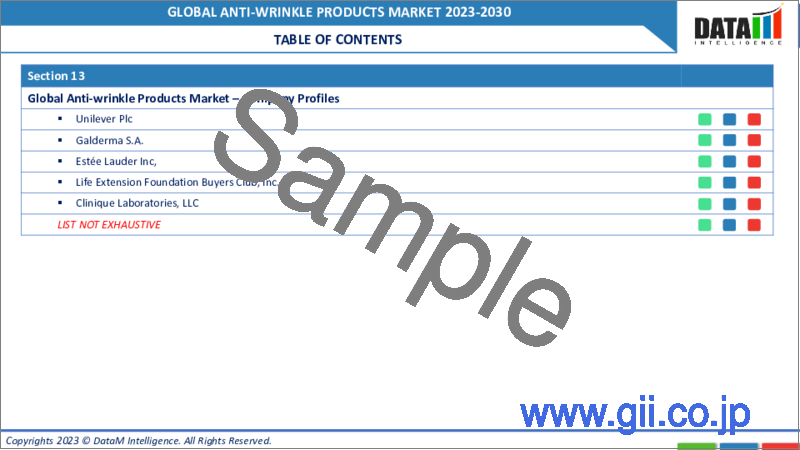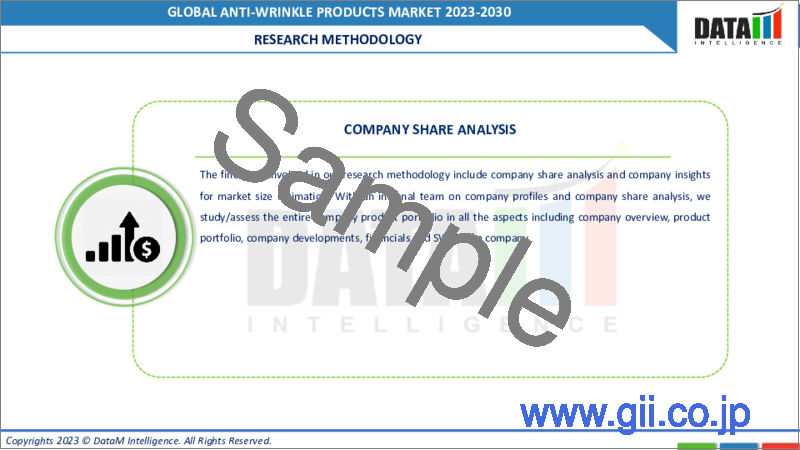|
|
市場調査レポート
商品コード
1262755
抗シワ製品の世界市場-2023-2030Global Anti-wrinkle Products Market - 2023-2030 |
||||||
|
● お客様のご希望に応じて、既存データの加工や未掲載情報(例:国別セグメント)の追加などの対応が可能です。 詳細はお問い合わせください。 |
|||||||
| 抗シワ製品の世界市場-2023-2030 |
|
出版日: 2023年04月21日
発行: DataM Intelligence
ページ情報: 英文 195 Pages
納期: 約2営業日
|
- 全表示
- 概要
- 目次
市場概要
アンチリンクル製品の世界市場規模は、予測期間中(2023-2030年)7.54%のCAGRで成長しています。
アンチリンクル製品は、クリーム、オイル、ローション、美容液、ジェルなど、さまざまなタイプで構成されています。アンチリンクルクリームは、老化のプロセスを遅らせる成分を含んでいるため、人気が高まっています。シワの主な要因は、重要な栄養素の不足、紫外線や公害への長期的な曝露、喫煙、脱水、薬物の使用、遺伝的傾向などが挙げられます。植物性、天然、オーガニックのスキンケア製品に対する消費者の需要の高まりが、予測期間中の市場成長を後押ししています。消費者の間で自然な美しさを求める傾向が強まり、予測期間中の市場成長を後押しします。
市場力学
抗シワ製品のイノベーションが進むことで
企業は、他社より優位に立つために、M&Aや新製品の発売など、さまざまな戦略に力を注いでいます。例えば、ノーブルパナシアは、ノーベル賞を受賞したアイクリームの復元という絶対的なコレクションを発見しました。彼の研究により、数十年前から「有機分子容器」と呼ばれる画期的なスキンケア技術が開発されています。(OMV)を開発しました。OMVは、活性化学物質を驚異的な精度で肌細胞に届け、効能と鮮度を保ちながら老化症状を予防・治療することを目的としています。オルフェウスが見つけた、復活のオールインワン美容液。ギリシャとブルガリアの小さなパッチでしか見られない希少なオルフェウスの花は、最長31カ月間完全乾燥に耐えた後、たった1滴の水で緑豊かな状態にまで回復すると言われています。オルフェウス・スキンケアの創始者であるサラ・キュルクチエヴァは、植物幹細胞科学と持続可能なバイオテクノロジーにより、この奇跡の花に着目し、独自のオルフェウス花細胞ペプチド複合体を開発しました。抗酸化作用のある花エキス、強力なペプチド、植物幹細胞のトリプルショットが、天然のコラーゲンを促進するよう働きかけます。
消費者の間で高まるパーソナルケアの動向
老齢、公害、不健康な生活習慣、多忙な多忙なライフスタイルなど、皮膚のしわの問題を引き起こすいくつかの要因が、しわ防止製品市場の成長の原因となっています。主要なキープレイヤーは、天然スキンケア製品の製造に注力しています。オーガニックスキンケア製品に対する消費者の需要の高まりが、市場の成長を後押ししています。さらに、サロンやスパ、小売店、オンラインショップなど、さまざまな店舗でパーソナルケア製品を購入できるようになったことも、パーソナルケア製品の需要拡大に役立っています。
COVID-19影響度分析
COVID-19分析では、COVID前シナリオ、COVIDシナリオ、COVID後シナリオに加え、価格力学(パンデミック時やCOVID前シナリオとの比較による価格変動を含む)、需要-供給スペクトラム(取引制限、封鎖、その後の問題による需要と供給のシフト)、政府の取り組み(政府機関による市場、セクター、産業の活性化に関する取り組み)、メーカーの戦略的取り組み(COVID問題を軽減するためのメーカーの取り組み)についても解説しています。
目次
第1章 調査手法とスコープ
- 調査手法
- 調査目的および調査範囲について
第2章 定義と概要
第3章 エグゼクティブサマリー
- 製品タイプ別スニペット
- 有効成分別スニペット
- 流通チャネル別スニペット
- エンドユーザー別スニペット
- 地域別スニペット
第4章 ダイナミックス
- 影響要因
- 促進要因
- 抑制要因
- 機会
- 影響度分析
第5章 産業分析
- ポーターのファイブフォース分析
- サプライチェーン分析
- 価格分析
- 規制分析
第6章 COVID-19の分析
- COVID-19の解析について
- COVID-19シナリオ前
- 現在のCOVID-19シナリオ
- ポストCOVID-19または将来シナリオ
- COVID-19 の中での価格ダイナミクス
- 需給スペクトル
- パンデミック時の市場に関連する政府の取り組み
- メーカーの戦略的な取り組み
- 結論
第7章 製品タイプ別
- クリーム
- オイル
- 化粧水
- 美容液
- ゲル
- その他
第8章 有効成分別
- レチノイド
- ナイアシンアミド
- ビタミンC
- ヒドロキシ酸類
- グリコール酸(Glycolic Acid
- その他
第9章 流通チャネル別
- スーパーマーケット&ハイパーマーケット
- スペシャリティストア
- 薬局・薬店
- オンライン
第10章 エンドユーザー別
- 男性
- 女性
第11章 地域別
- 北米
- 米国
- カナダ
- メキシコ
- 欧州
- ドイツ
- 英国
- フランス
- イタリア
- ロシア
- その他欧州
- 南米
- ブラジル
- アルゼンチン
- その他南米地域
- アジア太平洋地域
- 中国
- インド
- 日本
- オーストラリア
- その他アジア太平洋地域
- 中東・アフリカ地域
第12章 競合情勢
- 競合シナリオ
- 市況分析・シェア分析
- M&A分析
第13章 企業プロファイル
- L'Oreal Groupe
- 会社概要
- 製品ポートフォリオと説明
- 財務概要
- 主な展開
- Olay
- CeraVe
- Neutrogena
- RoC Skincare
- POND'S
- Galderma S.A.
- The Estee Lauder Companies Inc.
- Life Extension
- Vichy Laboratoires
上記以外を含む
第14章 付録
Market Overview
The Global Anti-wrinkle Products Market size reached US$ XX million in 2022 and is projected to witness lucrative growth by reaching up to US$ XX million by 2030. The market is growing at a CAGR of 7.54% during the forecast period (2023-2030).
Anti-wrinkle products consist of various types such as creams, oil, lotion, serum, gel, and others. Anti-wrinkle creams are becoming more popular since they have ingredients that slow down the aging process. Major contributing factors to wrinkles include a deficiency of vital nutrients, prolonged exposure to UV radiation and pollution, smoking, dehydration and drug use, as well as a genetic tendency. An increase in the consumer demand for plant-based, natural, organic skin products helps to boost the market growth in the forecast period. An increase in the natural beauty trend among consumers helps to boost the market growth in the forecast period.
Market Dynamics
The growing innovations in the anti-wrinkle products
Companies focus on various strategies, such as M&As and new product launches, to gain a competitive edge over others. For instance, Noble Panacea found an absolute collection of restoring eye creams that is a Nobel Prize winner. His study has led to the development of revolutionary skincare technology known as Organic Molecular Vessels, which has been decades in the making. (OMV). OMV is designed to deliver active chemicals to skin cells with astonishing accuracy, preventing and treating aging symptoms while maintaining potency and freshness. Orpheus found a resurrection all-in-one serum. The rare Orpheus flower, which is only found in small patches in Greece and Bulgaria, is said to be able to recover to a lush green state with just one drop of water after enduring full dryness for up to 31 months. To create their proprietary Orpheus Flower Cell Peptide Complex, the astute founder of Orpheus Skincare, Sara Kyurkchieva, centered her two flagship products, Resurrection All-In-One Serum and Resurrection Bio-Luminous Dewy Essence, around this miraculous flower using plant stem cell science and sustainable biotechnology. This concentrated triple shot of antioxidant-rich flower extracts, potent peptides, and plant stem cells works together to boost natural collagen.
The growing rate of personal care trends among consumers
Some of the factors causing skin wrinkles problems such as old age, pollution, unhealthy habits, and busy hectic lifestyle are responsible for the growth of the anti-wrinkle products market. The major key players are focusing on manufacturing natural skin care products. The increase in the consumer demand for organic skin care products helps to boost the market growth. Moreover, an increase in the availability of personal care products in various outlets such as salons, spas, retail stores, and online shops also helps to increase demand for personal care products.
COVID-19 Impact Analysis
The COVID-19 Analysis includes Pre-COVID Scenario, COVID Scenario and Post-COVID Scenario along with Pricing Dynamics (Including pricing change during and post-pandemic comparing it with pre-COVID scenarios), Demand-Supply Spectrum (Shift in demand and supply owing to trading restrictions, lockdown and subsequent issues), Government Initiatives (Initiatives to revive market, sector or Industry by Government Bodies) and Manufacturers Strategic Initiatives (What manufacturers did to mitigate the COVID issues will be covered here).
Segment Analysis
The global anti-wrinkle products market is segmented based on product type, active ingredients, distribution channel, end user and region.
Owing to the increasing product launches with active ingredients like vitamin C, the segment is expected to grow
In the active ingredients segment, vitamin C accounted largest market share due to its positive effect on the skin and the increase in product launches with vitamin C content in the market. Vitamin C has various benefits for the skin such as it promotes collagen production and protecting skin from the sun damage. It is safe for all skin types. It provides hydration and bright skin. It helps to reduce hyperpigmentation and reduce the appearance of under-eye circles. Vitamin C also helps to prevent sagging. An increase in product launches by major key players helps to boost segment growth in the forecast period. For instance, NeoStrata Company, Inc launched Vitamin C + Antiaging Booster in the market. Pure vitamin C has anti-aging properties since it is necessary for the production of collagen, which firms skin and reduces wrinkles. In addition to shielding skin from aging free radicals, vitamin C helps skin regain radiance.
Ggeographical Analysis
The strong presence of major players and increased awareness about the use of skincare products
North American region accounted largest market share due to the increase in disposable income of the consumers. The United States and Canada are major shareholding countries in the region due to the increase in the awareness of using anti-wrinkle products. The personal care business in the US has been expanding quickly in the forecast period. Over time, consumers in the nation have seen an increase in their average yearly spending on personal and beauty care items, which is fueling the market's expansion there. The demand for anti-wrinkle products in the United States has grown significantly over time as a result of many cosmetic companies abandoning traditional advertising in favor of leveraging well-known celebrities and influencers to advertise their goods to target groups. These factors help to boost the market growth in the forecast period.
Competitive Landscape
The major global players include L'Oreal Groupe, Olay, CeraVe, Neutrogena, RoC Skincare, POND'S, Galderma S.A., The Estee Lauder Companies Inc., Life Extension, and Vichy Laboratoires.
Why Purchase the Report?
- To visualize the global anti-wrinkle products market segmentation based on product type, active ingredients, distribution channel, end user and region, as well as understand key commercial assets and players.
- Identify commercial opportunities by analyzing trends and co-development.
- Excel data sheet with numerous data points of anti-wrinkle products market-level with all segments.
- PDF report consists of a comprehensive analysis after exhaustive qualitative interviews and an in-depth study.
- Product mapping available as Excel consisting of key products of all the major players.
The global anti-wrinkle products market report would provide approximately 69 tables, 91 figures and 195 pages.
Target Audience 2023
- Manufacturers/ Buyers
- Industry Investors/Investment Bankers
- Research Professionals
- Emerging Companies
Table of Contents
1. Methodology and Scope
- 1.1. Research Methodology
- 1.2. Research Objective and Scope of the Report
2. Definition and Overview
3. Executive Summary
- 3.1. Snippet by Product Type
- 3.2. Snippet by Active Ingredients
- 3.3. Snippet by Distribution Channel
- 3.4. Snippet by End User
- 3.5. Snippet by Region
4. Dynamics
- 4.1. Impacting Factors
- 4.1.1. Drivers
- 4.1.2. Restraints
- 4.1.3. Opportunity
- 4.1.4. Impact Analysis
5. Industry Analysis
- 5.1. Porter's Five Forces Analysis
- 5.2. Supply Chain Analysis
- 5.3. Pricing Analysis
- 5.4. Regulatory Analysis
6. COVID-19 Analysis
- 6.1. Analysis of COVID-19
- 6.1.1. Before COVID-19 Scenario
- 6.1.2. Present COVID-19 Scenario
- 6.1.3. Post COVID-19 or Future Scenario
- 6.2. Pricing Dynamics Amid COVID-19
- 6.3. Demand-Supply Spectrum
- 6.4. Government Initiatives Related to the Market During the Pandemic
- 6.5. Manufacturers' Strategic Initiatives
- 6.6. Conclusion
7. By Product Type
- 7.1. Introduction
- 7.1.1. Market Size Analysis and Y-o-Y Growth Analysis (%), By Product Type
- 7.1.2. Market Attractiveness Index, By Product Type
- 7.2. Cream *
- 7.2.1. Introduction
- 7.2.2. Market Size Analysis and Y-o-Y Growth Analysis (%)
- 7.3. Oil
- 7.4. Lotion
- 7.5. Serum
- 7.6. Gel
- 7.7. Others
8. By Active Ingredients
- 8.1. Introduction
- 8.1.1. Market Size Analysis and Y-o-Y Growth Analysis (%), By Active Ingredients
- 8.1.2. Market Attractiveness Index, By Active Ingredients
- 8.2. Retinoids *
- 8.2.1. Introduction
- 8.2.2. Market Size Analysis and Y-o-Y Growth Analysis (%)
- 8.3. Niacinamide
- 8.4. Vitamin C
- 8.5. Hydroxy Acids
- 8.6. Glycolic Acid
- 8.7. Others
9. By Distribution Channel
- 9.1. Introduction
- 9.1.1. Market Size Analysis and Y-o-Y Growth Analysis (%), By Distribution Channel
- 9.1.2. Market Attractiveness Index, By Distribution Channel
- 9.2. Supermarkets & Hypermarkets *
- 9.2.1. Introduction
- 9.2.2. Market Size Analysis and Y-o-Y Growth Analysis (%)
- 9.3. Specialty Stores
- 9.4. Pharmacies & Drugstores
- 9.5. Online
10. By End User
- 10.1. Introduction
- 10.1.1. Market Size Analysis and Y-o-Y Growth Analysis (%), By End User
- 10.2. Market Attractiveness Index, By End User
- 10.3. Men *
- 10.3.1. Introduction
- 10.3.2. Market Size Analysis and Y-o-Y Growth Analysis (%)
- 10.4. Women
11. By Region
- 11.1. Introduction
- 11.1.1. Market Size Analysis and Y-o-Y Growth Analysis (%), By Region
- 11.1.2. Market Attractiveness Index, By Region
- 11.2. North America
- 11.2.1. Introduction
- 11.2.2. Key Region-Specific Dynamics
- 11.2.3. Market Size Analysis and Y-o-Y Growth Analysis (%), By Product Type
- 11.2.4. Market Size Analysis and Y-o-Y Growth Analysis (%), By Active Ingredients
- 11.2.5. Market Size Analysis and Y-o-Y Growth Analysis (%), By Distribution Channel
- 11.2.6. Market Size Analysis and Y-o-Y Growth Analysis (%), By End User
- 11.2.7. Market Size Analysis and Y-o-Y Growth Analysis (%), By Country
- 11.2.7.1. The U.S.
- 11.2.7.2. Canada
- 11.2.7.3. Mexico
- 11.3. Europe
- 11.3.1. Introduction
- 11.3.2. Key Region-Specific Dynamics
- 11.3.3. Market Size Analysis and Y-o-Y Growth Analysis (%), By Product Type
- 11.3.4. Market Size Analysis and Y-o-Y Growth Analysis (%), By Active Ingredients
- 11.3.5. Market Size Analysis and Y-o-Y Growth Analysis (%), By Distribution Channel
- 11.3.6. Market Size Analysis and Y-o-Y Growth Analysis (%), By End User
- 11.3.7. Market Size Analysis and Y-o-Y Growth Analysis (%), By Country
- 11.3.7.1. Germany
- 11.3.7.2. UK
- 11.3.7.3. France
- 11.3.7.4. Italy
- 11.3.7.5. Russia
- 11.3.7.6. Rest of Europe
- 11.4. South America
- 11.4.1. Introduction
- 11.4.2. Key Region-Specific Dynamics
- 11.4.3. Market Size Analysis and Y-o-Y Growth Analysis (%), By Product Type
- 11.4.4. Market Size Analysis and Y-o-Y Growth Analysis (%), By Active Ingredients
- 11.4.5. Market Size Analysis and Y-o-Y Growth Analysis (%), By Distribution Channel
- 11.4.6. Market Size Analysis and Y-o-Y Growth Analysis (%), By End User
- 11.4.7. Market Size Analysis and Y-o-Y Growth Analysis (%), By Country
- 11.4.7.1. Brazil
- 11.4.7.2. Argentina
- 11.4.7.3. Rest of South America
- 11.5. Asia-Pacific
- 11.5.1. Introduction
- 11.5.2. Key Region-Specific Dynamics
- 11.5.3. Market Size Analysis and Y-o-Y Growth Analysis (%), By Product Type
- 11.5.4. Market Size Analysis and Y-o-Y Growth Analysis (%), By Active Ingredients
- 11.5.5. Market Size Analysis and Y-o-Y Growth Analysis (%), By Distribution Channel
- 11.5.6. Market Size Analysis and Y-o-Y Growth Analysis (%), By End User
- 11.5.7. Market Size Analysis and Y-o-Y Growth Analysis (%), By Country
- 11.5.7.1. China
- 11.5.7.2. India
- 11.5.7.3. Japan
- 11.5.7.4. Australia
- 11.5.7.5. Rest of Asia-Pacific
- 11.6. Middle East and Africa
- 11.6.1. Introduction
- 11.6.2. Key Region-Specific Dynamics
- 11.6.3. Market Size Analysis and Y-o-Y Growth Analysis (%), By Product Type
- 11.6.4. Market Size Analysis and Y-o-Y Growth Analysis (%), By Active Ingredients
- 11.6.5. Market Size Analysis and Y-o-Y Growth Analysis (%), By Distribution Channel
- 11.6.6. Market Size Analysis and Y-o-Y Growth Analysis (%), By End User
12. Competitive Landscape
- 12.1. Competitive Scenario
- 12.2. Market Positioning/Share Analysis
- 12.3. Mergers and Acquisitions Analysis
13. Company Profiles
- 13.1. L'Oreal Groupe *
- 13.1.1. Company Overview
- 13.1.2. Product Portfolio and Description
- 13.1.3. Financial Overview
- 13.1.4. Key Developments
- 13.2. Olay
- 13.3. CeraVe
- 13.4. Neutrogena
- 13.5. RoC Skincare
- 13.6. POND'S
- 13.7. Galderma S.A.
- 13.8. The Estee Lauder Companies Inc.
- 13.9. Life Extension
- 13.10. Vichy Laboratoires
LIST NOT EXHAUSTIVE
14. Appendix
- 14.1. About Us and Services
- 14.2. Contact Us




